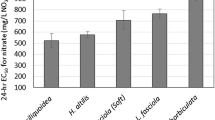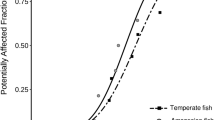Abstract
Indigenous species are less commonly used in laboratory aquatic toxicity tests compared with standard test species due to (1) limited availability lack of requisite information necessary for their acclimation and maintenance under laboratory conditions and (2) lack of information on their sensitivity and the reproducibility of toxicity test results. As part of the Natural Resource Damage Assessment aquatic toxicity program in response to the Deepwater Horizon Oil incident (2010), sensitive life stages of native Gulf of Mexico species were evaluated in laboratory toxicity tests to determine the potential effects of the spill. Fish (n = 5) and invertebrates (n = 2) selected for this program include the following: the Florida pompano (Trachinotus carolinus), red drum (Sciaenops ocellatus), spotted sea trout (Cynoscion nebulosus), cobia (Rachycentron canadum), red porgy (Pagrus pagrus), blue crab (Callinectes sapidus), and the common moon jellyfish (Aurelia aurita). Initially in the program, to establish part of the background information, acute tests with reference toxicants (CdCl2, KCl, CuSO4) were performed with each species to establish data on intraspecies variability and test precision as well as identify other factors that may affect toxicity results. Median lethal concentration (LC50) values were calculated for each acute toxicity test with average LC50 values ranging from 248 to 862 mg/L for fish exposures to potassium chloride. Variability between test results was determined for each species by calculating the coefficient of variation (%CV) based on LC50 values. CVs ranged from 11.2 % for pompano (96-h LC50 value) to 74.8 % for red porgy 24-h tests. Cadmium chloride acute toxicity tests with the jellyfish A. aurita had the lowest overall CV of 3.6 %. By understanding acute toxicity to these native organisms from a compound with known toxicity ranges and the variability in test results, acute tests with nonstandard species can be better interpreted and used appropriately when determining risk.



Similar content being viewed by others
References
American Public Health Association (1981) Standard methods for the examination of water and wastewater, 15th edn. American Water Works Association, and Water Pollution Control Federation, Washington, DC
American Society for Testing and Materials (1980) Standard practice for conducting acute toxicity tests with fish, macroinvertebrates and amphibians. ASTM E729-80¸ATSM, Philadelphia
Berking S, Czech N, Gerharz M, Herrmann K, Hoffmann U, Raifer H et al (2005) A newly discovered oxidant defense system and its involvement in the development of Aurelia aurita (Scyphozoa: Cnidaria): reactive oxygen species and elemental iodine control medusa formation. Int J Dev Biol 49:969–976
Biomonitoring Science Advisory Board (1994) West Coast Marine Species Chronic Variability Study: criteria for acceptable variability of marine chronic toxicity test methods. Washington State Advisory Board, Olympia
Cairns J Jr (1994) Third wave ecotoxicology. Ecotoxicol 3:1–3
Calabrese A, Collier RS, Nelson DA, MacInnes JR (1973) The toxicity of heavy metals to embryos of the American oyster Crassostrea virginica. Mar Biol 18:162–166
Chapman PM (1995) Ecotoxicology and pollution—key issues. Mar Pollut Bull 31:167–177
Cherry DS, Van-Hassel JH, Farris JL, Soucek DJ, Neves RJ (2002) Site-specific derivation of acute copper criteria for the Clinch River, Virginia. Hum Ecol Risk Assess 8:591–601
Conides AJ, Glamuzina B (2001) Study on the early larval development and growth of the red porgy, Pagrus pagrus, with emphasis on the mass mortalities observed during this phase. Sci Mar 65:193–200
Cripe GM (1994) Comparative acute toxicities of several pesticides and metals to Mysidopsis bahia and postlarval Penaeus duorarum. Environ Toxicol Chem 13:1867–1872
DeWitt TH, Redmond MS, Sewall JE, Swartz RC (1992) Development of a chronic sediment toxicity test for marine benthic amphipods. Report number CBP/TRS 83/93 United States Environmental Protection Agency, Pacific Ecosystems Branch, Newport, OR
Dorn PB, Rodgers JH (1989) Variability associated with identification of toxics in National Pollutant Discharge Elimination System (NPDES) effluent toxicity tests. Environ Toxicol Chem 8:893–902
Echols BS, Currie RJ, Cherry DS (2010) Preliminary results of laboratory toxicity tests with the Mayfly, Isonychia bicolor (Ephemeroptera: Isonychiidae) for development as a standard test organism for evaluating streams in the Appalachian coalfields of Virginia and West Virginia. Environ Monit Assess 169:487–500
Environment Canada (1990) Guidance document on control of toxicity test precision using reference toxicants. EPS1/RM/12, Environment Canada, Ottawa
Fabre-Domergue J, Bietrix E (1897) La pèriode critique postlarvae des poisons marins. Bull Mus Natl d’Hist Nat Paris 3:57–58
Fucik KW, Carr KA, Balcom BJ (1994) Dispersed oil toxicity tests with biological species indigenous to the Gulf of Mexico. Prepared by the Continental Shelf Associates, Inc. for the U.S. Department of the Interior, Minerals Management Service, Gulf of Mexico OCS Region, New Orleans, LA
Harter VL, Matthews RA (2005) Acute and chronic toxicity test methods for Nematostella vectensis Stephenson. Bull Environ Contam Toxicol 74:830–836
Hernandez-Cruz CM, Sahli M, Bessonart M, Izquierdo MS, Gonzalez MM, Fernandez-Palacios H (1999) Rearing techniques for red porgy (Pagrus pagrus) during larval development. Aquaculture 179:489–497
Hjort J (1914) Fluctuations in the great fisheries of northern Europe viewed in the light of biological research. Rapp Proc-Verbaux Rèun Cons Perm Intern Pour L’Explor de la Mer 20:1–228
Incardona JP, Gardner LD, Linbo TL, Brown TL, Esbaugh AJ, Mager EM et al (2014) Deepwater Horizon crude oil impacts the developing hearts of large predatory pelagic fish. Proc Natl Acad Sci USA 111:E1510–E1518
Lee DR (1980) Reference toxicants in quality control of aquatic bioassays. In: Cairns J, Buikema AL (eds) Aquatic invertebrate bioassays. American Society for Testing and Materials, STP 715, Baltimore, p 209
Mager EM, Esbaugh AJ, Stieglitz JD, Hoenig R, Bodinier C, Incardona JP et al (2014) Acute embryonic or juvenile exposure to Deepwater Horizon crude oil impairs the swimming performance of mahi-mahi (Coryphaena hippurus). Environ Sci Technol 48:7053–7061
May RC (1974) Larval mortality in marine fishes and the critical period concept. In: Blaxter JHS (ed) The early life history of fish. The Proceedings of an International Symposium Held at the Dunstaffnage Marine Research Laboratory of the Scottish Marine Biological Association at Oban, Scotland, May 17–23, 1973. Springer, Berlin–Heidelberg, Germany, pp. 3–19
Milam CD, Farris JL, Dwyer FJ, Hardesty DK (2005) Acute toxicity of six freshwater mussel species (glochidia) to six chemicals: implications for daphnids and Utterbackia imbecillis as surrogates for protection of freshwater mussels (Unionidae). Arch Environ Contam Toxicol 48:166–173
Moore DRJ, Warren-Hicks W, Parkhurst BR, Teed RS, Baird RB, Berger R et al (2000) Intra-and intertreatment variability in reference toxicant tests: implications for whole effluent toxicity testing programs. Environ Toxicol Chem 19:105–112
Morris JA, Rezek MC, McNeill NA, Watanabe WO (2008) Aquaculture of the Atlantic red porgy. N Am J Aquac 70:184–191
Newman MC (1995) Quantitative methods in aquatic ecotoxicology. Lewis, Boca Raton
Newman MC, Clements WH (2008) Ecotoxicology—a comprehensive treatment. Taylor & Francis, Boca Raton
Pesticide Action Network (PAN) (2014) Available at: http://www.panna.org/. Accessed: November 2014
Rand GM (1995) Fundamentals of aquatic toxicology. Effects, environmental fate, and risk assessment, 2nd edn. Taylor and Francis, London, p 1125
Rand GM, Gardinali PR, Markarian R, Huddleston M, Kubitz J, Stubblefield W (2011) Evaluation of environmental exposures, toxicity methodology and modeling needs: The NRDA aquatic toxicology research program to better understand potential toxicity, hazards and injury of petroleum hydrocarbons to marine organisms. Presented at the 2011 Gulf Oil Spill SETAC Focused Topic Meeting, Pensacola, FL, April 28, 2011
Rand GM, Gardinali PR, Stubblefield WA, Huddleston W, Echols BS, BenKinney MT, et al. (2012) Comprehensive marine toxicity program to address the potential toxicity of petroleum hydrocarbons from the DWH incident in the Gulf of Mexico, Florida. Paper presented at SETAC North America 33rd Annual Meeting, Long Beach, CA, November 11, 2012
Richardson BJ, Martin M (1994) Marine and estuarine toxicity testing: a way to go? Additional sittings from Northern and Southern Hemisphere perspectives. Mar Pollut Bull 28:138–142
Rogevich EC, Hoang TC, Rand GM (2009) Effects of sublethal chronic copper exposure on the growth and reproductive success of the Florida apple snail (Pomacea paludosa). Arch Environ Contam Toxicol 56:450–458
United States Environmental Protection Agency (1975) Methods for acute toxicity tests with fish, macroinvertebrates, and amphibians. EPA-600/3-75-009. National Environmental Research Center, Office of Research and Development, USEPA, Corvallis, OR
United States Environmental Protection Agency (1978) Bioassay procedures for the ocean disposal permit program. EPA-600/9-78-010. Environmental Research Laboratory, Office of Research and Development, USEPA, Washington, DC
United States Environmental Protection Agency (1993) Methods for measuring the acute toxicity of effluents and receiving waters to freshwater and marine organisms (4th ed). EPA/600-4-90/027F. Environmental Monitoring Systems Laboratory–Cincinnati, Office of Research and Development, USEPA, Cincinnati, OH
United States Environmental Protection Agency (2002) Methods for measuring the acute toxicity of effluents and receiving waters to freshwater and marine organisms. EPA-821-R-02–012. Office of Water, USEPA, Washington, DC
Wang N, Augspurger T, Barnhart MC et al (2007) Intra-and interlaboratory variability in acute toxicity tests with glochidia and juveniles of freshwater mussels (Unionidae). Environ Toxicol Chem 26:2029–2035
Acknowledgments
This work was supported by BP Exploration and Production Inc. and the BP Gulf Coast Restoration Organization. The authors thank Alex Ontkos, Nadia Boyer, Gabriel Miller, and Gabriel Diaz for assistance in the acclimation, rearing, and testing for each of these species. This is contribution number 696 from the Southeast Environmental Research Center at Florida International University.
Author information
Authors and Affiliations
Corresponding author
Rights and permissions
About this article
Cite this article
Echols, B.S., Smith, A.J., Rand, G.M. et al. Factors Affecting Toxicity Test Endpoints in Sensitive Life Stages of Native Gulf of Mexico Species. Arch Environ Contam Toxicol 68, 655–662 (2015). https://doi.org/10.1007/s00244-014-0122-7
Received:
Accepted:
Published:
Issue Date:
DOI: https://doi.org/10.1007/s00244-014-0122-7




